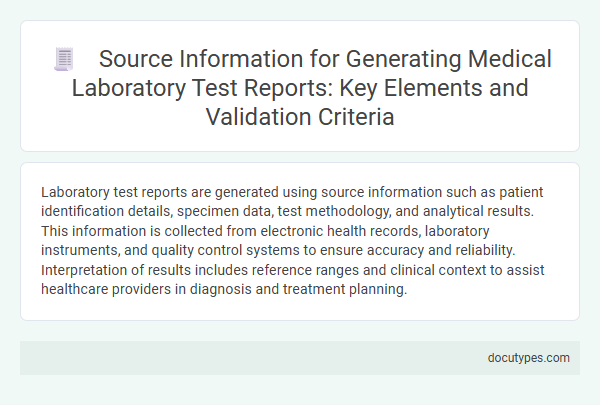Laboratory test reports are generated using source information such as patient identification details, specimen data, test methodology, and analytical results. This information is collected from electronic health records, laboratory instruments, and quality control systems to ensure accuracy and reliability. Interpretation of results includes reference ranges and clinical context to assist healthcare providers in diagnosis and treatment planning.
Introduction to Source Information in Medical Laboratory Test Reports
Medical laboratory test reports rely on precise source information to ensure accurate diagnosis and treatment. Understanding the origin of this data is crucial for healthcare professionals interpreting lab results.
- Patient Demographics - Includes age, sex, and medical history critical for contextualizing test outcomes.
- Specimen Details - Information about specimen type, collection time, and handling impact test validity.
- Testing Methodologies - Laboratory techniques and instruments used affect result accuracy and interpretation.
Accurate source information is foundational to the reliability and clinical utility of laboratory test reports.
Essential Elements of Source Data in Laboratory Reporting
Laboratory test reports rely on accurate source data to ensure precise diagnosis and effective patient management. Essential elements of source information support the credibility and clarity of laboratory findings.
- Patient Identification - Includes patient name, date of birth, and unique medical record number to accurately link results to the individual.
- Specimen Information - Details such as specimen type, collection date, and time ensure traceability and relevance of the sample tested.
- Test Methodology - Documentation of the testing method and equipment used provides context for result interpretation and quality assurance.
Standards and Guidelines for Source Information Documentation
Laboratory test reports rely on standardized source information to ensure accuracy and consistency. Adherence to established standards and guidelines is critical for reliable documentation and interpretation of test results.
- CLSI Guidelines - The Clinical and Laboratory Standards Institute provides comprehensive protocols for documenting source information in laboratory test reports.
- ISO 15189 Standards - These international standards specify the quality and competence requirements for medical laboratories, including the proper documentation of patient and specimen data.
- HL7 Messaging Standards - Health Level Seven standards facilitate the structured exchange of clinical and administrative data, ensuring clear and uniform source information presentation in reports.
Patient Identification and Demographic Data
Patient identification and demographic data form the foundation of a laboratory test report. These details ensure accurate matching of test results to the correct individual, preventing errors and misdiagnoses.
This source information includes the patient's full name, date of birth, gender, and unique identification numbers. You provide this critical data during sample collection, enabling precise tracking and reporting throughout the testing process.
Specimen Collection Details: Time, Method, and Personnel
Laboratory test reports rely heavily on accurate specimen collection details, including the exact time the sample was obtained. Precise timing ensures the reliability of test results by correlating sample integrity with the patient's physiological state.
The method of specimen collection, such as venipuncture, swab, or catheterization, is carefully documented to maintain procedural consistency and validity. Information about the trained personnel performing the collection is recorded to verify adherence to clinical standards and reduce the risk of contamination or error.
Analytical Methodology and Instrumentation
Laboratory test reports are generated using data derived from specific analytical methodologies and instrumentation. These include validated techniques such as spectrophotometry, chromatography, and immunoassays applied to biological samples.
The instrumentation involved often consists of devices like mass spectrometers, automated analyzers, and clinical chemistry analyzers, each calibrated to ensure accuracy and precision. Analytical methods are selected based on the test requirements, sensitivity, and specificity for detecting target analytes. Quality control measures are integral during analysis to maintain reliability and reproducibility of the test results presented in the report.
Reference Ranges and Units of Measurement
Laboratory test reports rely on source information such as patient samples, analytical instruments, and standardized databases to generate accurate results. Reference ranges represent the normal values established from healthy populations, providing a comparative framework for interpreting test outcomes. Units of measurement adhere to internationally recognized standards, ensuring consistency and clarity across different laboratories and healthcare settings.
Data Validation and Verification Criteria
| Source Information Used to Generate a Laboratory Test Report | |
|---|---|
| Patient Identification Data | Unique identifiers such as patient ID, name, date of birth, and medical record number ensure accuracy in associating test results with the correct individual. |
| Specimen Details | Information on specimen type, collection time, and handling conditions are validated to maintain sample integrity and relevance. |
| Test Methodology | Details of laboratory techniques and equipment used are verified to comply with standard procedures and quality control measures. |
| Analytical Instrument Data | Raw output and calibration records from diagnostic instruments are checked for consistency and precision to ensure reliability of results. |
| Quality Control Records | Internal and external quality control data confirm that tests meet established accuracy and sensitivity standards. |
| Data Validation and Verification Criteria | Automated and manual review processes validate data completeness, range checks, and logical consistency. Verification ensures your test report is accurate and trustworthy before release. |
| Reference Ranges and Interpretive Guidelines | Validated normal values and clinical annotations are integrated to assist interpretation within the context of your health status. |
Quality Assurance and Control Measures
Laboratory test reports are generated using data from certified instruments, calibrated equipment, and validated reagents to ensure accuracy. Quality assurance protocols include regular proficiency testing, internal quality control charts, and adherence to standardized procedures. Your healthcare provider relies on these rigorous control measures to deliver reliable and precise diagnostic information.
What Source Information Is Used to Generate a Laboratory Test Report? Infographic

